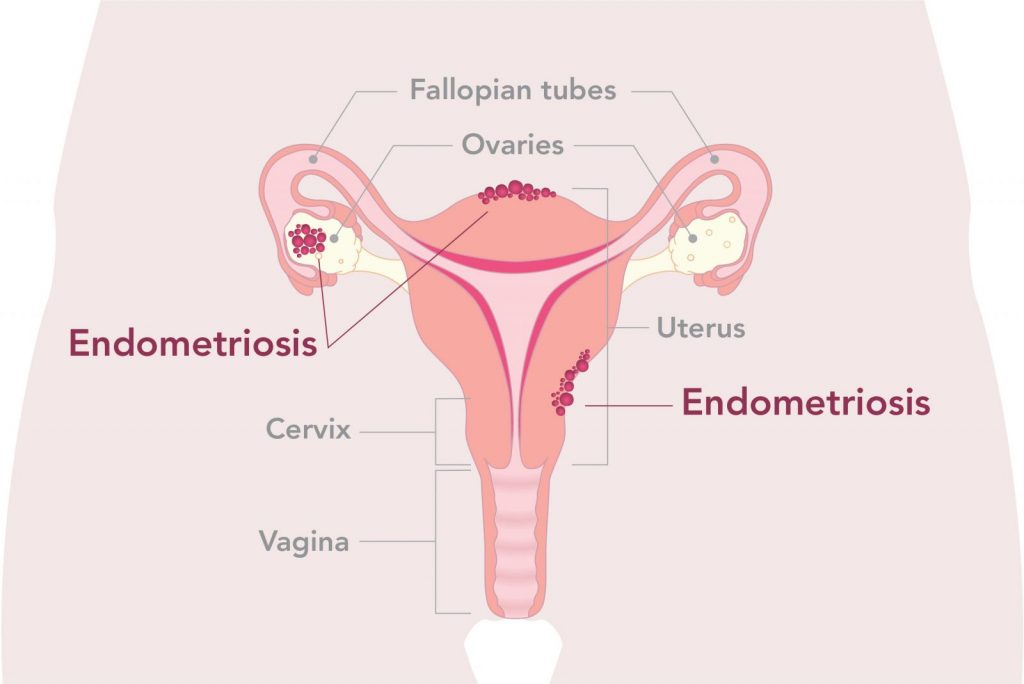*Note: this will be a series of two blog posts
Endometriosis (or “endo” as it is most commonly phrased) is a progressive and chronic inflammatory disease characterised by the growth of endometrium-like tissue outside the uterine cavity1.
What does this mean exactly? Well, to put it simply, tissue that typically resides inside the uterus, grows in areas outside of it. Whilst these endometrium-like cells can grow in various parts of the body, they are most commonly found on organs in the pelvis such as the ovaries and fallopian tubes (as illustrated in the image below)1. When endometriosis involves the ovaries, endometriomas (cysts on ovaries) may form.
What exactly occurs with endometriosis?
Elevated levels of oestrogen (relative to progesterone) contribute to the growth of endometrium cells and for this reason, endometriosis is considered an oestrogen-dependant disease. With each menstrual cycle, endometrium tissue that grows outside of the uterus, thickens, breaks down, and bleeds just like it does when inside the uterus. However, as it does not have an exit path, it becomes trapped resulting in a build-up of tissue and with time, scar tissue and adhesions form. This ‘trapped’ shedding of tissue, adhesions and sometimes also cysts, leads to inflammation in the body which commonly causes pain.
Due to inflammation, women with endometriosis tend to have an overactive immune system too. As the gut is a major immune organ, gastrointestinal symptoms and sensitivities are also very common such as food intolerances, bloating (often referred to as ‘endo belly’), constipation, diarrhoea, nausea and digestive pain.
Is endometriosis common and what causes it?
Currently, it is known that 1 in 10 women of reproductive age are affected by this painful and debilitating disease2. Although frighteningly common, the cause/s of endometriosis are not fully understood1,2. In fact, it is thought that the possible contributing factors differ considerably amongst women1.
Nevertheless, factors which may increase one’s risk of developing endometriosis include1,2,3:
- Genetics/family history
- Retrograde menstruation (menstrual blood flows back along the fallopian tube)
- Type of period i.e. heavy bleeding, periods lasting longer than 5 days
- Long exposures to oestrogen i.e. experiencing your first period at a young age
- Change in immune cells
- Low body weight
Symptoms
Unsurprisingly, just like the aetiology of endometriosis, symptoms vary among women, are non-specific and, overlap with other diseases3. As a result, accurate diagnosis can be lengthy. In fact, studies have shown that the average diagnosis time is 7 years1. This frustratingly lengthy prognosis may also be due to the progression of symptoms commonly being slow and steady.
It is also important to mention that the severity and types of symptoms do not reflect the severity of endometriosis1,3. In fact, the severity and types of symptoms experienced, are likely a reflection of the location of endometrial tissue1.
Keeping all of the above in mind, the most common symptoms reported include1,2,3:
Pain– pelvic, abdominal or back pain – pain during intercourse |
Heavy or irregular bleeding |
Bleeding for longer than normal |
Bloating |
Changes in bowel habits |
Tiredness or low energy |
Changes in mood– anxiety and/or depression |
Reduced quality of life– taking days off work etc. due to an inability to function normally |
Although these symptoms are often cyclical, they can be experienced at any time of the month3.
As I’m sure you can tell, symptoms are extremely generic and as such, overlap with a broad range of conditions. Therefore, if you are reading this and thinking “this could be me”, it is crucial to seek professional medical advice before jumping to any conclusions!
I have been diagnosed with endometriosis – now what?
Although endometriosis cannot be cured, there is emerging and exciting evidence arising on how it can be managed. To read more about managing endo, click here for part 2.
References:
- Endometriosis symptoms and causes [Internet]. Jean Hailes – For Women’s Health. 2019 [cited 24 June 2021]. Available from: https://www.jeanhailes.org.au/health-a-z/endometriosis/symptoms-causes
- Signorile PG, Baldi A. New evidence in endometriosis. International Journal of Biochemistry and Cell Biology. 2015;60:19-22.
- Parasar P, Ozcan P, Terry KL. Endometriosis: Epidemiology, Diagnosis and Clinical Management. Curr Obstet Gynecol Rep. 2017;6(1):34-41.
Written by Jasmine Genau
Jasmine is a student nutritionist and aspiring dietitian from Deakin University with a special interest in fertility health, pregnancy and paediatric nutrition, mental health, and sports nutrition. Upon completion of her masters, Jasmine aspires to work as a clinical dietitian and to initially upskill in the areas of paediatric and sports nutrition.



